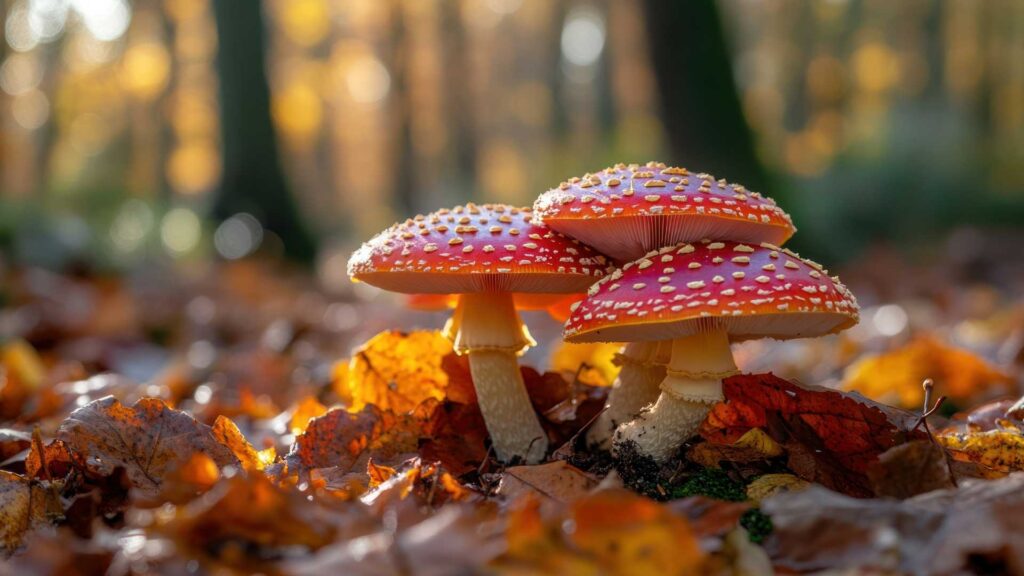The psychoactive fungus Amanita muscaria presents itself through a distinctive red-and-white appearance. Muscimol and ibotenic acid produce dream-like sedative effects instead of traditional hallucinations, unlike the active compounds found in psilocybin mushrooms.
People tend to use this mushroom in spiritual practices, although its usage requires careful attention because of its dangerous side effects.
In this blog, we’ll examine the behavioral changes caused by Amanita muscaria, discussing the cultural historical context of its use, and following a review of safety regulations regarding usage.
What Is Amanita muscaria?
Amanita muscaria stands as a member of the Amanita genus among mushroom species with a scientific name known as fly agaric.
The mushroom stands out because of its identifiable shape, which makes it widely recognizable among other fungi. Amanita muscaria displays its large red or orange, or yellow-colored cap along with white spots or warts on its surface.
White spots and warts commonly occur on the mushroom’s cap.
The mushroom extends white support from the base, where it also gains its firmness. The base of the mushroom contains a partial veil that shapes structures like skirt or ring formations along the stem.
With mushroom maturation, the cap expands while it uncovers the interior gills that run underneath, which are white.
Amanita muscaria mushrooms grow throughout regional areas of North America along with Europe, and Asia. The mushrooms occur mainly in coniferous and deciduous forests due to their mycorrhizal growth patterns with trees.
The active compounds in Amanita muscaria mushrooms have psychoactive properties that can lead to different levels of consciousness transformation. The main psychoactive agent present in these mushrooms exists as muscimol.
During decarboxylation, Ibotenic acid found in Amanita muscaria mushrooms converts into muscimol. The brain receptors accept these compounds, which result in modifications to human perception, together with cognitive changes.
Amanita muscaria mushrooms have existed since ancient times, and people have employed them for spiritual and Indigenous ceremonial activities.
Throughout history, they have appeared prominently in mythology and folklore and have become associated with mystical powers that can bring transformation and magical enchantment.
Is Amanita Muscaria Poisonous?
The poison classification of Amanita muscaria stems from its ibotenic acid content, together with other toxins found in the mushroom. Amanita muscaria toxins produce several harmful side effects that bring about vomiting and nausea alongside dizziness.
Proper drying or cooking procedures convert ibotenic acid into muscimol, which becomes the main active chemical and the responsible psychoactive compound of the mushrooms.
The change of ibotenic acid into muscimol creates less toxic substances and stronger psychedelic properties.
The reduction of toxicity risk depends on having proper preparation procedures. Ordinary mushroom preparation methods, such as drying and cooking, reduce the amount of ibotenic acid in mushrooms.
The individual reaction to mushrooms remains variable because different people possess different sensitivities to food, despite preparation techniques.
An assessment of underlying health conditions as well as allergies remains essential because these factors can increase the danger of adverse reactions.
People should exercise careful use and handling when dealing with Amanita muscaria mushrooms as a safety measure. People should begin with minimal doses that enable individuals to understand their reaction pattern and adaptation levels.
Mycologists, along with healthcare professionals, should be consulted about potential consumption because they have expert knowledge to advise.
Historical & Cultural Significance
1. Ancient Wisdom and Shamanic Traditions
The ancient world has recognized Amanita Muscaria mushrooms through their use in traditional indigenous spiritual practices.
Shamans who acted as mystical spiritual leaders would consume these mushrooms to obtain altered states of consciousness, which enabled them to experience deep spiritual transformations.
Through the consumption of mushrooms, shamans obtained vital knowledge and spiritual guidance from the spirit world.
2. Legends, Folklore, and Enchantment
These mushrooms exist prominently in cultural myths and legendary stories alongside magical stories. Different cultures relate these fungi to magical elements while placing them as key features in fairytales, along with artworks and literary works.
According to European folklore traditions, Amanita Muscaria mushrooms gained their reputation because of their believed power to bring luck and facilitate metamorphosis.
3. Contemporary Perspectives and Utilization:
Today, Amanita Muscaria mushrooms exist as substances used for different applications.
Responsible individuals use Amanita Muscaria mushrooms to discover psychoactive effects, which help them experience new things while fostering personal development.
Research has directed focus toward Amanita mushrooms because scientists believe they possess therapeutic advantages in addition to helping people experience altered states.
Potential Benefits of Amanita Muscaria Mushroom
While research is limited, anecdotal reports suggest several possible effects:
1. Altered Perception & Relaxation
- Unlike psilocybin (which causes visual hallucinations), Amanita muscaria produces dream-like, dissociative effects.
- Some users describe a calm, meditative state.
2. Mood Enhancement
- May promote euphoria and introspection in moderate doses.
3. Sleep Support
- Some microdosers report improved sleep quality due to its sedative properties.
4. Traditional Medicinal Use
- Historically used for pain relief and stress reduction (though modern evidence is lacking).
How Is Amanita Muscaria Consumed?
Due to its raw toxicity, Amanita muscaria is rarely eaten fresh. Common preparation methods include:
1. Drying & Decarboxylation
- Heating converts ibotenic acid into muscimol, reducing toxicity.
- Dried caps are brewed into tea or smoked.
2. Tinctures & Extracts
- Alcohol-based extracts provide controlled dosing.
3. Microdosing
- Some users take small amounts for subtle cognitive effects.
Potential Side Effects of Amanita muscaria
Amanita muscaria can be toxic if improperly prepared. Potential risks include:
- Nausea & dizziness (common at higher doses)
- Confusion or delirium (in excessive amounts)
- Muscle twitches or sedation
Legal Status of Amanita Muscaria
The U.S government does not control Amanita muscaria mushrooms in the same way it regulates psilocybin mushrooms.
The sale of this substance has legal restrictions established in certain states. Before buying, make sure to confirm that your local laws permit it.
Final Thoughts
Nature provides the Amanita muscaria mushroom as a captivating psychedelic substance that produces psychoactive effects unlike any other natural psychedelic agent.
The mushroom possesses great cultural importance, but contemporary users need to exercise safety because of uncertain outcomes during improper preparation processes.
Any person interested in learning about its properties should undertake complete research by first administering small doses from trusted suppliers.
The psychedelic properties of Amanita muscaria attract both disciplined psychonauts and traditional ethnobotanical researchers, but it should not be used for basic experimentation.
Further research is expected to deliver better comprehension regarding both the uses and advantages of Amanita muscaria.
Those who want to examine Amanita muscaria should practice responsible use together with proper respect for this highly potent fungus.

